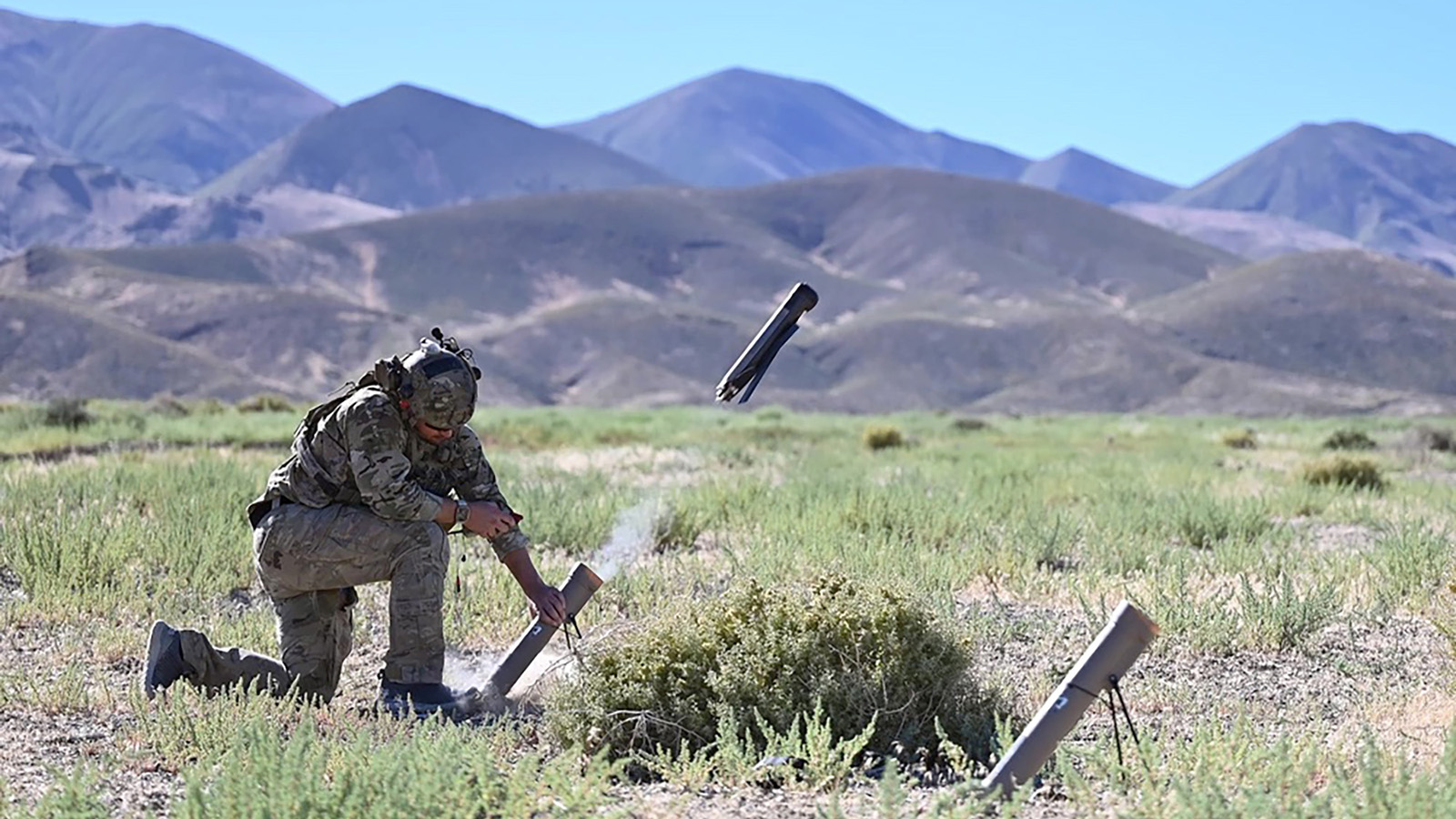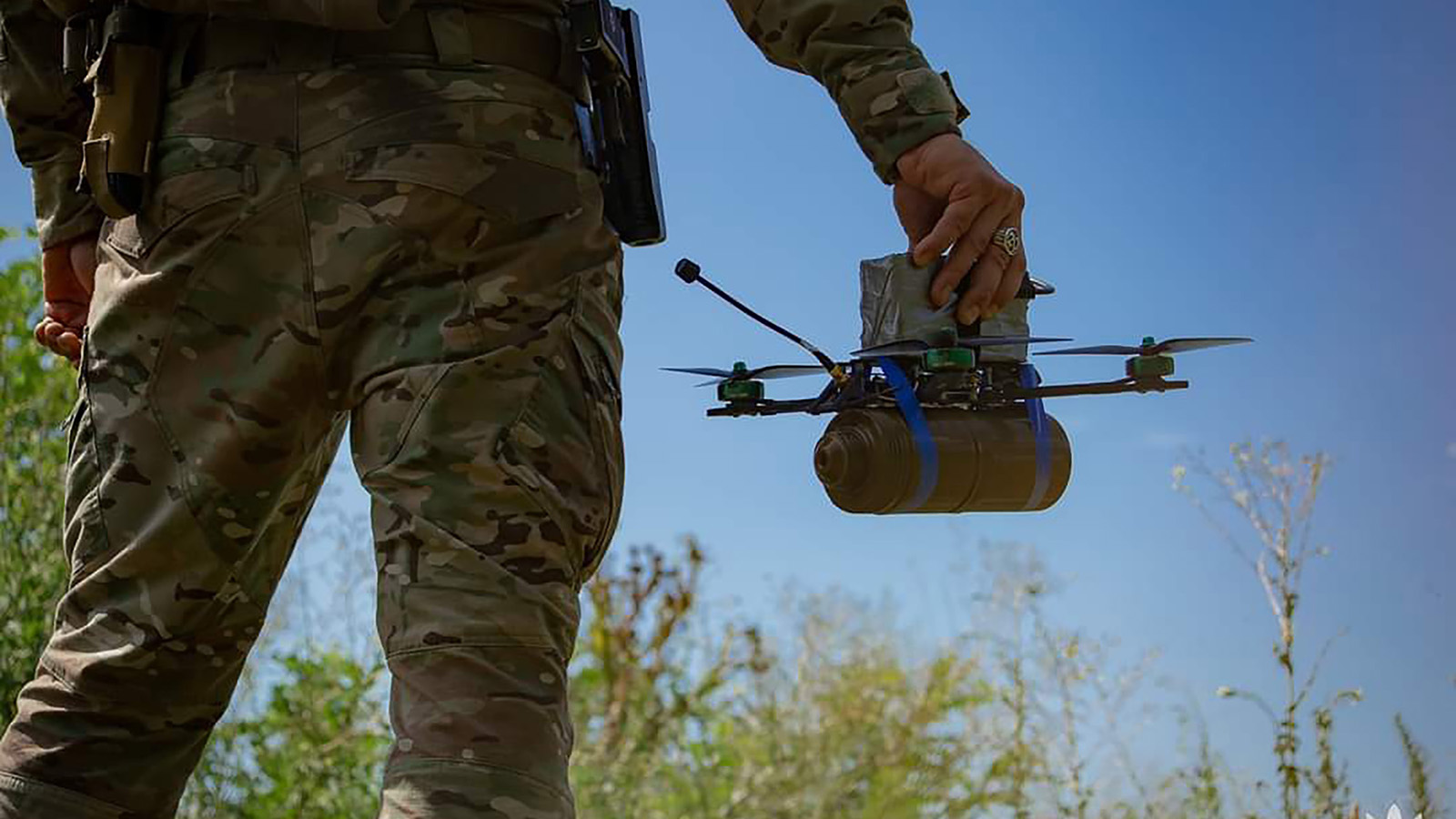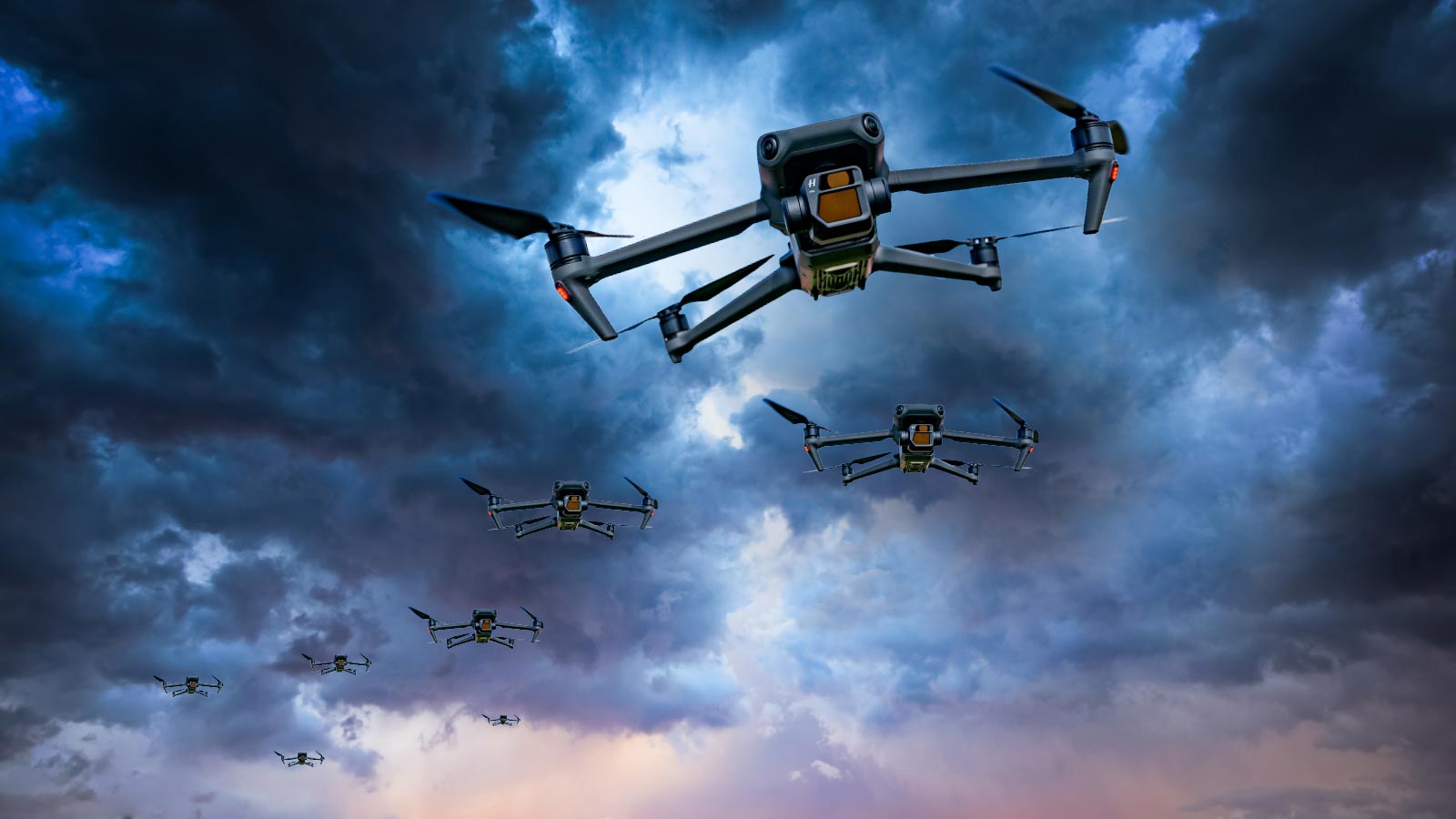Stay Up to Date
Submit your email address to receive the latest industry and Aerospace America news.
There was a time when “drone war” conjured images of Cessna-sized aircraft flying over enemy lands while their controllers monitored them from half a world away in a trailer. Ukraine has shown U.S. planners that a more visceral, fast-paced, innovate-or-die drone scenario could lie ahead. Keith Button spoke to researchers who want the U.S. to be ready.
Last August, U.S. researchers funded by the U.S. Department of Homeland Security tested a technique for defeating swarm drone attacks like those experienced by Ukrainian forces over the past two years. Three quadcopters were flown in a stacked formation toward radar and electro-optic/infrared sensors set up in an open field owned by Oklahoma State University. An engineer sitting under a tent saw the single dot on his computer tablet map turn into three: The technology had done its job of recognizing that there were actually three aircraft, not one. He tapped a red button on the screen to jam their radio frequencies, halting their forward flight.
For Jamey Jacob, an Oklahoma State professor and the liaison to DHS during the tests last year, defeating the drones amounted to one of many lessons in preparedness that the United States must draw from the losses suffered by Ukrainian forces in their war with Russia. Those lessons, recent events suggest, aren’t something relevant only to hypothetical conflicts in the distant future. The Oklahoma experiment might have presaged a real-life drone attack that killed three U.S. soldiers at a military outpost in Jordan in January: The Wall Street Journal reported that an Iran-backed militia may have flown the attacking drone close to a U.S. surveillance drone that was returning to base to make it more difficult for air defenses to spot.
Jacob is among a coterie of researchers funded by the Pentagon, and in some cases DHS, and military think tank analysts who are drawing lessons from the war in Ukraine. While social media accounts and news reports are the most abundant sources of information, they also occasionally talk with Ukrainian forces and access U.S. intelligence reports, for those with security clearances. Of particular interest is the ever-evolving role of small drones, especially the consumer ones weighing just a couple kilograms, employed by Ukraine and also Russia.
Their primary goal? To help devise offensive and defensive drone capabilities to keep the U.S. from ever suffering a fate similar to that of Russia: a superpower stymied by cheap, modified off-the-shelf consumer drones deployed in mass quantities.

As important as the research in the field in Oklahoma and elsewhere will be to the endeavor, nothing can match the painful human lessons that are flowing from the battlefields of Ukraine, Jacob says. Researchers must ask themselves how this technology will work “at night, in the dark, in a foxhole, with rain,” he says. Not only that, a field experiment can never fully replicate the pace and unpredictability of war.
“We’re starting at 8 a.m. and we’re clocking out at 5, and we only have a week to be able to run this test; we can’t run through all the different scenarios,” he notes.
Jacob and others want to do all they can to help Ukraine too, but because the technology is evolving so quickly on the battlefield, it’s more likely that American researchers will end up learning more from Ukrainian drone operators than vice versa, he says.
From a drone research perspective, the U.S. military has never operated drones in a battle against an evenly matched opponent, notes Jacob. Until recently, “we’ve taken all of our lessons really focused on the asymmetric battlefield.”
Russia’s battlefield is more symmetric. Each side is mired in trench warfare against a closely matched opponent. Frontline troops on both sides launch deadly attacks and reconnaissance flights with drones weighing 1 or 2 kilograms. Russia ended up in the predicament of trying to take territory without the benefits of air superiority because of Ukraine’s success at tracking and shooting down Russian aircraft from the ground with missiles, says Kelly Grieco, an airpower analyst and senior fellow at the Stimson Center in Washington, D.C.
It’s tempting, she says, to view air warfare as a battle of airplanes — how an F-16 might fare versus a MiG fighter jet, for example. In reality, the most important aspect of the air war in Ukraine has been defenses such as “shoot and scoot” missile launchers on trucks that soldiers can set up, fire at planes and then drive away before the enemy can home in on their radar signal to fire back, she says.
Over the last 30 years, the U.S. has become accustomed to gaining air superiority over battlefields and denying its adversaries the ability to use the airspace. Yet in the Ukraine war, Russia hasn’t gained air superiority despite having an air force 10 times larger than Ukraine’s, Grieco says.
“That’s a remarkable accomplishment, given this asymmetry of power.”
Russia hasn’t pressed its 10-to-1 advantage because it doesn’t want to risk losing expensive planes and pilots. In a future war against an evenly matched adversary, the U.S. could also find itself not willing to take that risk, she says. “The United States has built increasingly an air force around a smaller number of expensive, exquisite aircraft. But those smaller numbers mean that when you take losses, you lose — very quickly — significant combat power.”
In addition to piloted planes, large, expensive drones like the $32 million MQ-9 Reapers are vulnerable to being shot down in a “nonpermissive” environment like that of the Ukraine war, says Gordon “Skip” Davis, a retired U.S. Army major general and senior fellow with the Transatlantic Defense and Security Program at the Washington, D.C.-based Center for European Policy Analysis, CEPA.
That may be why the Reaper is a NATO asset, yet “not on the Ukrainian shopping list,” according to Jacob. Early in the war, Ukraine deployed a rough equivalent to the Predator, the $5 million Turkish-made Bayraktar TB2, but once Russia organized its air defenses, the TB2 was vulnerable and it disappeared from the battlefield, notes Grieco.
Even aside from the small-drone observations of U.S. researchers and Department of Defense officials who steer their research, from a big-picture view, seeing Ukraine hold off a seemingly superior Russian air force will push the U.S. into developing and fielding more uncrewed aircraft in general, Grieco predicts. Increasingly, air forces are assigning their most important missions to roboticized air power, and the Ukraine war has accelerated the trend, she says.
“It’s becoming a war about missiles and drones, not the crewed, inhabited bombers and fighter jets that we traditionally associate with air wars.”

Modified off-the-shelf small drones are supplying many of the war’s lessons for U.S. researchers and military analysts. In addition to drones all of sizes built for military use, both Russian and Ukrainian forces have employed commercial drones, such as DJI Mavic quadcopters designed for amateur video photography and racing. These are cheaper and harder to shoot down than similarly sized U.S. military drones like the Indago quadcopter and fixed-wing Raven and Puma, and often better at precisely delivering explosive payloads. A $1,000 modified off-the-shelf drone has destroyed million-dollar tanks, while presenting a practical target size only 15 centimeters wide — difficult to shoot down while whizzing by 100 meters above the ground, Jacob says.
Ukrainian forces have adapted consumer drones to drop grenades or carry mortar shells as kamikaze aircraft to blow themselves up on a target, as well as to surveil enemy troops and artillery positions and to direct artillery fire on those positions. The degree to which the small drones have exposed troops and their positions has been unprecedented — concealing soldier movement and positions is extremely difficult with the ever-present threat of drones watching and attacking from above, Davis says.
“That’s taken people by surprise just how much the vulnerability has increased due to this transparency,” he says. “It changes the warfare in all domains, primarily right now in the land and maritime, even though it’s an air domain tool.”
Because of the threat, Russian units usually choose to attack in the pre-dawn hours and move troops and supplies under the cover of darkness, Grieco says, and Ukraine intends to counter by adding night vision and infrared cameras to its drones. Their average lifespan is only a few days, with the Ukrainian troops losing 10,000 small drones per month, according to a November report by the Center for Strategic and International Studies, “Countering Small Aerial Systems: Air Defense by and for the Joint Force.” Ukraine is aiming to build 1 million drones, similar to the DJI Mavic, over the next year, Grieco says.
The dissonance between the retail and lethal uses of the commercial quadcopters is jarring. In the retail context, a DJI marketing video shows skateboarding teenagers pulling the drones and remote controllers from their backpacks, then donning first-person viewer googles to fly them over and through lush forests and canyons. In the wartime context, countless FPV videos posted online show an explosive-laden quadcopter barreling toward its target, such as a tank’s turret or the open back of a military truck, with any soldiers in view haplessly trying to duck away at the last moment. This is followed by a white-noise video screen signifying the drone’s explosion upon contact.
Mahendra Bhagwat, who heads basic research for the U.S. Army’s Vertical Lift Research Center of Excellence at Moffett Field, California, says he has been surprised at what the off-the-shelf drones were capable of with modifications from Ukrainian soldiers “jazzing them up,” such as extending their range or speeding them up with modifications to their propellers or batteries, mixing and matching new parts, or adding cellphone cameras to provide a drone’s-eye view.
Observing how these expendable drones have been deployed in the war has fueled interest into research of a new hybrid between drone and artillery munition that the U.S. is developing as a potential weapon for future wars, Bhagwat says. With shared characteristics of drones, which can be controlled with precision by a ground operator, and of expendable artillery shells, which are fired to arrive quickly on target, “that opens up a completely different type of warfare,” he says.
Jacob says he’s been impressed by low-cost military drones fielded by Ukraine that have many of the same capabilities of much more expensive military drones, yet are easier to operate. The Australian Corvo, for example, is a fixed-wing drone made of a cardboard-like material with low-cost electronics that ships in a flat form and can be assembled by troops on the front lines without much tech knowhow, he says.

For U.S. drone researchers, the war has helped shift their focus toward smaller aircraft, as they present a greater return on investment, Jacob says.
Also, “they’re certainly a lot easier for troops to take to the front lines to be able to operate from a tactical level,” he says. “It shows the importance of how these systems need to be integrated at the troop level, with the smaller and smaller groups, rather than filling these at a much larger scale and operating from air bases far behind the lines.”
As for countering the threat of small-drone attacks, U.S. researchers will need to address a gap between the offensive capabilities and anti-drone weapons. Counter-drone technology “is still playing a game of catch up,” Jacob says. Weapons can aim high-energy lasers or microwaves that fry electronic components of the drones, but their acquisition and operating costs are difficult to justify weighed against their effectiveness, he says. Lasers need a line of sight to the target, and microwave energy weapons have limited range and can fail if the targeted drone is insulated against attack.
“They’re still not quite there yet in being able to defeat that threat,” Jacob says. Jamming — either by disrupting the radio frequencies used to control the drone or by spoofing the drone’s GPS position to throw off its navigation — has the most promise for fending off wave attacks, he says.
Russian forces have exploited the weakness of counter-drone measures by sending in large numbers of drones to saturate Ukrainian defenses. In one 2022 example cited by the CSIS report, Russia overwhelmed Ukrainian air defenses with cheap, propeller-driven Iranian Shahed-136 drones — 550-kilogram winged bombs — then sent a second wave of cruise missiles targeting the power grid to damage winter heating.
To be effective, a variety of anti-drone detection technology and weapons will have to mesh with one another to protect from high-level attacks from thousands of meters above to just a few meters above, says Davis, the CEPA senior fellow. The options range from anti-aircraft guns like the German Gepard used by Ukrainian forces, to nets weighted with sandbags that are shot at drones, to directed energy and jamming devices, he says.

Jamming is the most common and effective countermeasure deployed by both Ukrainian and Russian forces, Grieco says: “There’s clearly a very active war going on electronically, even if it’s unseen, on both sides.”
U.S. research has so far produced reliable technology for detecting and identifying drones, but the next step — defeating the drone — has been the most difficult problem for researchers to solve, Jacob says. The challenge is to take out the threat without jamming your own drone’s radio frequencies or GPS, he says.
As counter-drone technologies are improved, researchers will have to find ways for drones to counter the counter, Davis says, such as with algorithms and artificial intelligence tools that manage radio frequency control by the drone operator and autonomous flying without the radio frequency. When the radio signal is on, it exposes the drone and potentially its operator to being targeted by anti-drone systems.
For example, at one point DJI modified software on its off-the-shelf drones so that its tracking system made the controller’s position measured and locatable, which allowed Russian soldiers to target and kill some Ukrainian operators, Jacob says. DJI is based in China, an ally and supplier of drones to Russia. When a frequency is jammed or GPS is spoofed, algorithms or AI could help find unjammed frequencies or to navigate with sensors.
Ultimately, the war has shown that the U.S. will have to adjust its model for developing drones and other aircraft, Grieco says. In the past, that model has been to substitute quality and technological advantage for quantity and to add capabilities to less expensive weapons that drive up their costs, she says.
But there comes a point where quantity is needed, she says, and the U.S. will need to produce drones on the scale of Ukraine’s million-drone goal. “It doesn’t matter how exquisite, how awesome the technology is; you need to have sufficient numbers.”
About Keith Button
Keith has written for C4ISR Journal and Hedge Fund Alert, where he broke news of the 2007 Bear Stearns hedge fund blowup that kicked off the global credit crisis. He is based in New York.
Related Posts
Stay Up to Date
Submit your email address to receive the latest industry and Aerospace America news.




